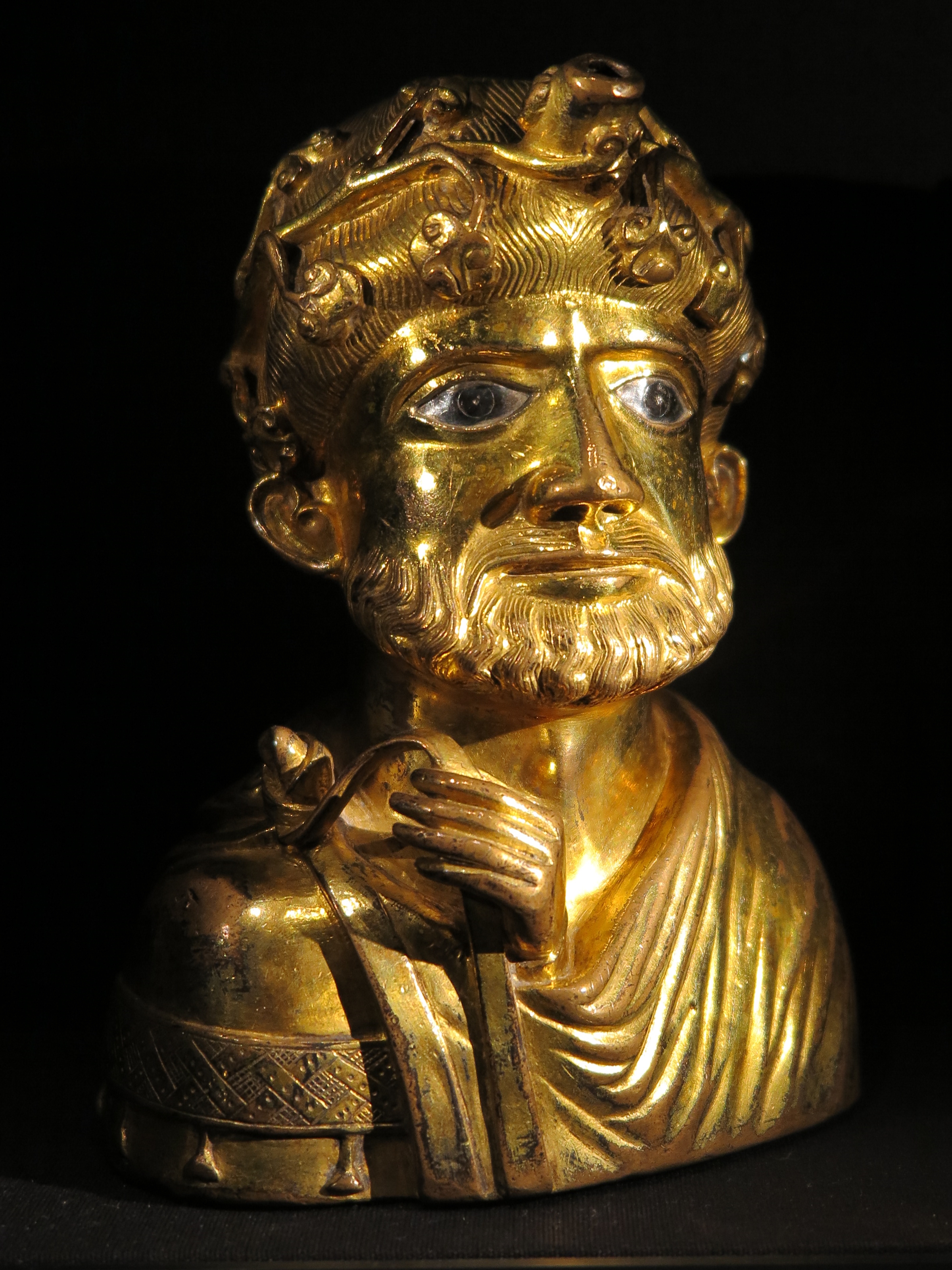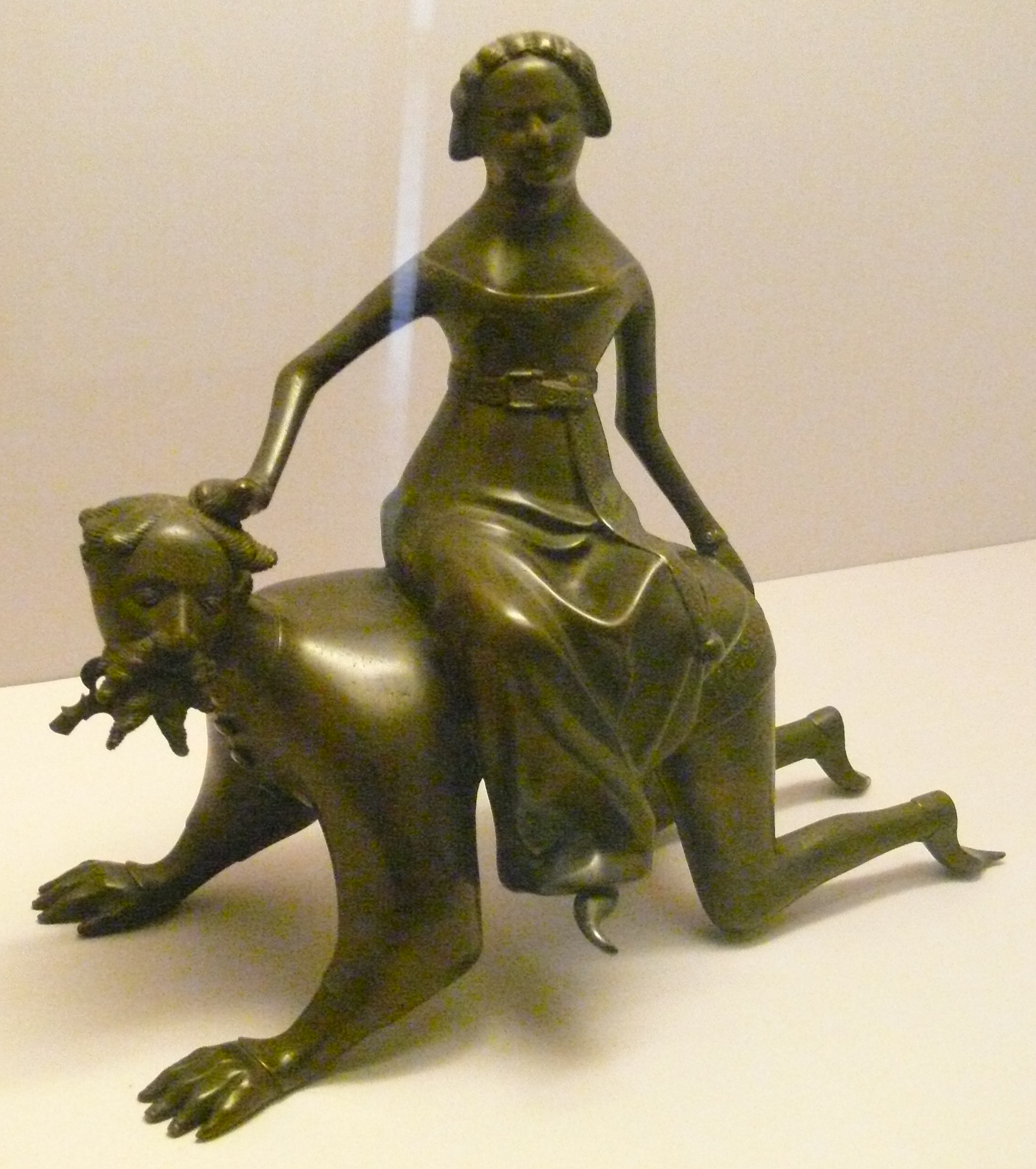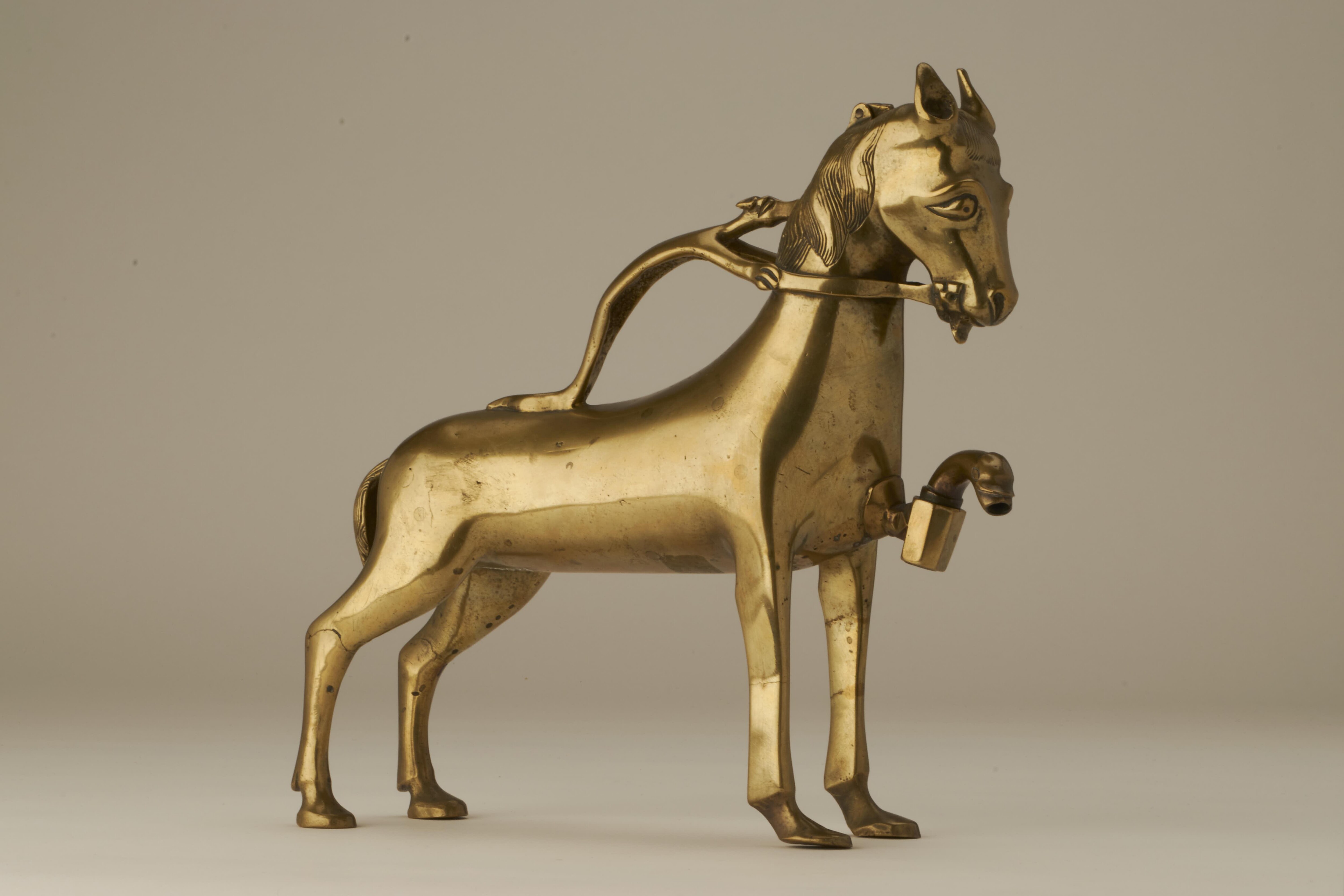Aquamanile on:
[Wikipedia]
[Google]
[Amazon]
 In modern usage, an aquamanile (plural aquamanilia or simply aquamaniles) is a
In modern usage, an aquamanile (plural aquamanilia or simply aquamaniles) is a 
 The
The  As well as the altar, aquamaniles were used at the tables of the great, where extravagant designs of symbolic or fantastical beasts – lions were especially popular – were developed in purely secular iconography. A gold aquamanile, c. 1215, in the treasury of the
As well as the altar, aquamaniles were used at the tables of the great, where extravagant designs of symbolic or fantastical beasts – lions were especially popular – were developed in purely secular iconography. A gold aquamanile, c. 1215, in the treasury of the

 The following aquamanilia in collections are set in approximate chronological order:
The following aquamanilia in collections are set in approximate chronological order:
State Hermitage Museum, Aquamanile in the form of an eagle, signed by "Suleiman" dated 180 AH/796-797
*
National Gallery of Art, Washington, Aquamanile in the form of a lion, north French or Mosan, c. 1200State Hermitage Museum, Aquamanile of a cow with her calf, Khorasan, dated CE 1206
handle in the form of a lion, attacking the cow by the hump of its back. *Khalili Collection of Islamic Art, Large aquamanile in the form of a feline, Iran or Afghanistan, early 13th century.
* ttp://www.rijksmuseum.nl/aria/aria_assets/BK-NM-14111?lang=en Rijksmuseum, Aquamanile in the form of a horse, bronze, Maas/Meuse region, 13th centurybr>Wartburg, Eisenach, Aquamanile in the form of a lion, 13th centuryLegion of Honor, San Francisco, Aquamanile of a lion, German, 13th century
*
Aquamanile (water vessel) in the form of a lion
13th or 14th century * Art Institute of Chicago
Aquamanile in the form of a lion
1325–75
* Walters Art Museum, ttps://art.thewalters.org/detail/19407/aquamanile-in-the-form-of-a-lion/ Aquamanile in the Form of a Lion brass, ca. 1300
Rijksmuseum, Aquamanile in the form of a lion, last quarter of the 14th century
*Germanisches National Museum
Aquamanile in the form of a lion
ca. 1400
Metropolitan Museum of Art, Aquamanile in the form of Aristotle and Phyllis, Lorraine, c. 1400The Cloisters Collection, Aquamanile in the form of a lion, copper alloy, Nuremberg, c. 1400
*Detroit Institute of Arts, Lion aquamanile, 1425–50 * The Hunt Museum
Horse Aquamanile, Germany, 15th century
* State Hermitage Museum, Aquamanile Shaped like a Rider from

European sculpture and metalwork
a collection catalog from The Metropolitan Museum of Art Libraries (fully available online as PDF), which contains material on aquamanile (see index) *Peter Barnet,
from the ''Heilbrunn Timeline of Art History'', September 2009. Storage vessels Eucharistic objects Medieval art Artworks in metal Medieval European metalwork objects
 In modern usage, an aquamanile (plural aquamanilia or simply aquamaniles) is a
In modern usage, an aquamanile (plural aquamanilia or simply aquamaniles) is a ewer
In American English, a pitcher is a container with a spout used for storing and pouring liquids. In English-speaking countries outside North America, a jug is any container with a handle and a mouth and spout for liquid – American "pitchers" wi ...
or jug
A jug is a type of container commonly used to hold liquids. It has an opening, sometimes narrow, from which to pour or drink, and has a handle, and often a pouring lip. Jugs throughout history have been made of metal, and ceramic, or glass, and ...
-type vessel in the form of one or more animal or human figures. It usually contained water for the washing of hands (''aqua'' + ''manos'') over a basin, which was part of both upper-class meals and the Christian Eucharist
The Eucharist (; from Greek , , ), also known as Holy Communion and the Lord's Supper, is a Christian rite that is considered a sacrament in most churches, and as an ordinance in others. According to the New Testament, the rite was instit ...
. Historically the term was sometimes used for any basin or ewer so used, regardless of shape. Most surviving examples are in metal, typically copper alloy
Copper alloys are metal alloys that have copper as their principal component. They have high resistance against corrosion. The best known traditional types are bronze, where tin is a significant addition, and brass, using zinc instead. Both of t ...
s (brass
Brass is an alloy of copper (Cu) and zinc (Zn), in proportions which can be varied to achieve different mechanical, electrical, and chemical properties. It is a substitutional alloy: atoms of the two constituents may replace each other wit ...
or bronze), as pottery versions have rarely survived.

Islamic art
Persian aquamaniles predate any zoomorphic aquamaniles known in Europe. An Iranian (Abbasid caliphate
The Abbasid Caliphate ( or ; ar, الْخِلَافَةُ الْعَبَّاسِيَّة, ') was the third caliphate to succeed the Islamic prophet Muhammad. It was founded by a dynasty descended from Muhammad's uncle, Abbas ibn Abdul-Muttalib ...
), aquamanile in the form of an eagle, bearing the date 180 AH/CE 796-797 is the earliest dated Islamic object in metalwork. It is cast in bronze, inlaid with silver and copper, and can be found in the Hermitage Museum
The State Hermitage Museum ( rus, Государственный Эрмитаж, r=Gosudarstvennyj Ermitaž, p=ɡəsʊˈdarstvʲɪn(ː)ɨj ɪrmʲɪˈtaʂ, links=no) is a museum of art and culture in Saint Petersburg, Russia. It is the largest ...
, St. Petersburg
Saint Petersburg ( rus, links=no, Санкт-Петербург, a=Ru-Sankt Peterburg Leningrad Petrograd Piter.ogg, r=Sankt-Peterburg, p=ˈsankt pʲɪtʲɪrˈburk), formerly known as Petrograd (1914–1924) and later Leningrad (1924–1991), i ...
, Russia
Russia (, , ), or the Russian Federation, is a transcontinental country spanning Eastern Europe and Northern Asia. It is the largest country in the world, with its internationally recognised territory covering , and encompassing one-eig ...
. The city of origin is unknown, as the inscription allows for a variety of interpretations. However, it is theorized that it was made in Iraq or Syria, due to the elaborate technique of decorative inlays that would only have been known to those areas at the time. It is possible that at one point, it was used as a weathervane, due to a hole between the feet; however, this has not been confirmed.
Among the latest in date is one also at the Hermitage, an Islamic aquamanile depicting a zebu
The zebu (; ''Bos indicus'' or ''Bos taurus indicus''), sometimes known in the plural as indicine cattle or humped cattle, is a species or subspecies of domestic cattle originating in the Indian sub-continent. Zebu are characterised by a fatty h ...
and calf, from Khorasan dated 1206. This object is also a rare example of an Islamic automaton
An automaton (; plural: automata or automatons) is a relatively self-operating machine, or control mechanism designed to automatically follow a sequence of operations, or respond to predetermined instructions.Automaton – Definition and More ...
, as the (now lost) harness and bridle were movable, as well as the tail, and the bell wrapped around its neck would have rung when poured. The symbolism of the young lion on the top of the aquamanile has been subject to academic debate, due to academic disagreement as to whether the lion is attacking the zebu or suckling on its back. However, some suggest that it is a depiction of the young mythological king Fereydun
Fereydun ( ae, 𐬚𐬭𐬀𐬉𐬙𐬀𐬊𐬥𐬀, Θraētaona, pal, 𐭯𐭫𐭩𐭲𐭥𐭭, ; New Persian: , ''Fereydūn/Farīdūn'') is an Iranian mythical king and hero from the Pishdadian dynasty. He is known as an emblem of victory, just ...
and represents his slow ascent to kingship from his humble beginnings as a cattle breeder.
While Islamic law forbids the use of animal depictions in religious settings, and few examples of Islamic aquamaniles survive, it is believed that they were used to a great extent in the Islamic world. The inscription on the zebu and calf from Khorasan states that it was "cast in one," or, in other words, was cast using the lost-wax casting
Lost-wax casting (also called "investment casting", "precision casting", or ''cire perdue'' which has been adopted into English from the French, ) is the process by which a duplicate metal sculpture (often silver, gold, brass, or bronze) i ...
process. The complexity of the piece suggests that the artisans involved had accomplished such a technical feat many times before. Aquamanilia were often commissioned by the emerging Islamic upper middle class as a display of wealth. Despite their uniqueness and rarity, Islamic aquamanilia are understudied.
Europe
 The
The Byzantine Empire
The Byzantine Empire, also referred to as the Eastern Roman Empire or Byzantium, was the continuation of the Roman Empire primarily in its eastern provinces during Late Antiquity and the Middle Ages, when its capital city was Constantinopl ...
's cultural connections with Sassanid Persia
The Sasanian () or Sassanid Empire, officially known as the Empire of Iranians (, ) and also referred to by historians as the Neo-Persian Empire, was the last Iranian empire before the early Muslim conquests of the 7th-8th centuries AD. Named ...
and the Abbasid
The Abbasid Caliphate ( or ; ar, الْخِلَافَةُ الْعَبَّاسِيَّة, ') was the third caliphate to succeed the Islamic prophet Muhammad. It was founded by a dynasty descended from Muhammad's uncle, Abbas ibn Abdul-Muttalib ...
caliphate, never peaceful in the political sphere, nevertheless brought the aquamanile into the Christian Mediterranean world. The earliest European portable aquamaniles date to the eleventh century.
Ewers and basins were needed in Christian liturgy for the ritual of the lavabo
A lavabo is a device used to provide water for the washing of hands. It consists normally of a ewer or container of some kind to pour water, and a bowl to catch the water as it falls off the hands. In ecclesiastical usage it refers to all of: the b ...
, in which the officiating priest washes his hands before vesting, again before the consecration of the Eucharist and after mass. As a ritual object, metal was considered more suitable than pottery, although most examples in pottery no doubt were broken and discarded. The aquamaniles made in the Mosan – or Meuse
The Meuse ( , , , ; wa, Moûze ) or Maas ( , ; li, Maos or ) is a major European river, rising in France and flowing through Belgium and the Netherlands before draining into the North Sea from the Rhine–Meuse–Scheldt delta. It has a t ...
valley – region, using the brass
Brass is an alloy of copper (Cu) and zinc (Zn), in proportions which can be varied to achieve different mechanical, electrical, and chemical properties. It is a substitutional alloy: atoms of the two constituents may replace each other wit ...
alloy of silvery tint called ''dinanderie'' (from the center of its manufacture in the region of Dinant) were often fantastic and zoomorphic in their forms, which were constrained only by the need for a larger opening for filling the vessel and a spout for pouring. Church records inventory aquamaniles in silver or gilt copper, but the great majority of surviving examples are in base metals, which were not worth melting down.
 As well as the altar, aquamaniles were used at the tables of the great, where extravagant designs of symbolic or fantastical beasts – lions were especially popular – were developed in purely secular iconography. A gold aquamanile, c. 1215, in the treasury of the
As well as the altar, aquamaniles were used at the tables of the great, where extravagant designs of symbolic or fantastical beasts – lions were especially popular – were developed in purely secular iconography. A gold aquamanile, c. 1215, in the treasury of the cathedral
A cathedral is a church that contains the '' cathedra'' () of a bishop, thus serving as the central church of a diocese, conference, or episcopate. Churches with the function of "cathedral" are usually specific to those Christian denominatio ...
at Aachen, takes the form of a man's bust; it is a rare survival of an aquamanile in a precious metal. An aquamanile (ref. Metropolitan Museum) in the form of Aristotle
Aristotle (; grc-gre, Ἀριστοτέλης ''Aristotélēs'', ; 384–322 BC) was a Greek philosopher and polymath during the Classical period in Ancient Greece. Taught by Plato, he was the founder of the Peripatetic school of ph ...
on hands and knees, being ridden by Phyllis, bore several moral lessons, with ribald undertones; such an aquamanile was distinctly secular in nature.
Bronze aquamaniles in the form of leopards were part of court ritual in Benin
Benin ( , ; french: Bénin , ff, Benen), officially the Republic of Benin (french: République du Bénin), and formerly Dahomey, is a country in West Africa. It is bordered by Togo to the west, Nigeria to the east, Burkina Faso to the nort ...
, where the concept may have arrived from the Islamic north. An 18th-century bronze leopard aquamanile from Benin is in the collection of the Minneapolis Institute of Arts
The Minneapolis Institute of Art (Mia) is an arts museum located in Minneapolis, Minnesota, United States. Home to more than 90,000 works of art representing 5,000 years of world history, Mia is one of the largest art museums in the United Stat ...
.
From the Renaissance elaborate versions of the conventional ewer were preferred to zoomorphic forms. A late version of the aquamanile was the silver-gilt mounted rider on a stand, bought in 1700 for the treasury of the Basilica of St-Denis and sold in 1798. Its form is recorded in an engraving by Félibien. (ref. St-Denis) The idea of ewer
In American English, a pitcher is a container with a spout used for storing and pouring liquids. In English-speaking countries outside North America, a jug is any container with a handle and a mouth and spout for liquid – American "pitchers" wi ...
s in fantastic shapes has never died out.
Examples

 The following aquamanilia in collections are set in approximate chronological order:
The following aquamanilia in collections are set in approximate chronological order:State Hermitage Museum, Aquamanile in the form of an eagle, signed by "Suleiman" dated 180 AH/796-797
*
Khalili Collection of Islamic Art
The Nasser D. Khalili Collection of Islamic Art includes 28,000 objects documenting Islamic art over a period of almost 1400 years, from 700 AD to the end of the twentieth century. It is the largest of the Khalili Collections: eight collections ...
, Aquamanile in the form of a goose, Khurasan, Iran, 12th century
*Khalili Collection of Islamic Art, Elephant aquamanile, Syria, 12th or early 13th century
* Museum für Kunst und Gewerbe Hamburg, Aquamanile in the form of a lion, ca. 1200National Gallery of Art, Washington, Aquamanile in the form of a lion, north French or Mosan, c. 1200
handle in the form of a lion, attacking the cow by the hump of its back. *Khalili Collection of Islamic Art, Large aquamanile in the form of a feline, Iran or Afghanistan, early 13th century.
* ttp://www.rijksmuseum.nl/aria/aria_assets/BK-NM-14111?lang=en Rijksmuseum, Aquamanile in the form of a horse, bronze, Maas/Meuse region, 13th centurybr>Wartburg, Eisenach, Aquamanile in the form of a lion, 13th century
*
Harvard University Art Museums
The Harvard Art Museums are part of Harvard University and comprise three museums: the Fogg Museum (established in 1895), the Busch-Reisinger Museum (established in 1903), and the Arthur M. Sackler Museum (established in 1985), and four research ...
, Fogg MuseumAquamanile (water vessel) in the form of a lion
13th or 14th century * Art Institute of Chicago
Aquamanile in the form of a lion
1325–75
* Walters Art Museum, ttps://art.thewalters.org/detail/19407/aquamanile-in-the-form-of-a-lion/ Aquamanile in the Form of a Lion brass, ca. 1300
Rijksmuseum, Aquamanile in the form of a lion, last quarter of the 14th century
*Germanisches National Museum
Aquamanile in the form of a lion
ca. 1400
Metropolitan Museum of Art, Aquamanile in the form of Aristotle and Phyllis, Lorraine, c. 1400
*Detroit Institute of Arts, Lion aquamanile, 1425–50 * The Hunt Museum
Horse Aquamanile, Germany, 15th century
* State Hermitage Museum, Aquamanile Shaped like a Rider from
Augsburg
Augsburg (; bar , Augschburg , links=https://en.wikipedia.org/wiki/Swabian_German , label=Swabian German, , ) is a city in Swabia, Bavaria, Germany, around west of Bavarian capital Munich. It is a university town and regional seat of the ...
, Germany, ca. 1665.

See also
*Bartmann jug
A Bartmann jug (from German ', "bearded man"), also called a Bellarmine jug, is a type of decorated salt-glazed stoneware that was manufactured in Europe throughout the 16th and 17th centuries, especially in the Cologne region, in what is today w ...
s, also known as ''Bellarmine jubs'', pottery jugs with bearded faces manufactured in Europe in 16th and 17th centuries.
* Toby jug, pottery jug in the form of a seated person, or the head.
* Cow creamer, ceramic or silver cream dispenser in the shape of a cow.
Notes

References
*Legner, Anton (ed). ''Ornamenta Ecclesiae, Kunst und Künstler der Romanik.'' Catalogue of an exhibition in the Schnütgen Museum, Köln, 1985. 3 vols. *Further reading
* * * * * Museo civico medievale di Bologna. ''L'acquamanile del Museo civico medievale di Bologna''. Conference proceedings. Milan: Silvana editoriale, 2013. * К. Ш. Средневековый акваманил: оригинал и копия. Новый взгляд на атрибуцию акваманилов из коллекции ГМИИ имени А. С. Пушкина Архивная копия от 6 марта 2016 на Wayback Machine// Актуальные проблемы теории и истории искусства: сб. науч. статей. Вып. 4. / Под ред. А. В. Захаровой,External links
{{commons categoryEuropean sculpture and metalwork
a collection catalog from The Metropolitan Museum of Art Libraries (fully available online as PDF), which contains material on aquamanile (see index) *Peter Barnet,
from the ''Heilbrunn Timeline of Art History'', September 2009. Storage vessels Eucharistic objects Medieval art Artworks in metal Medieval European metalwork objects